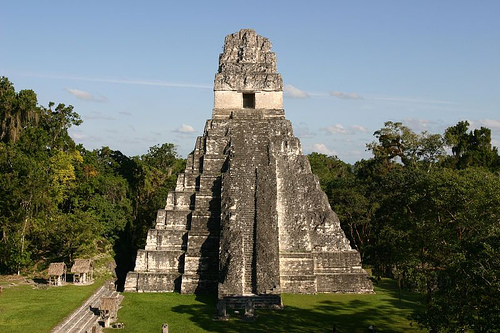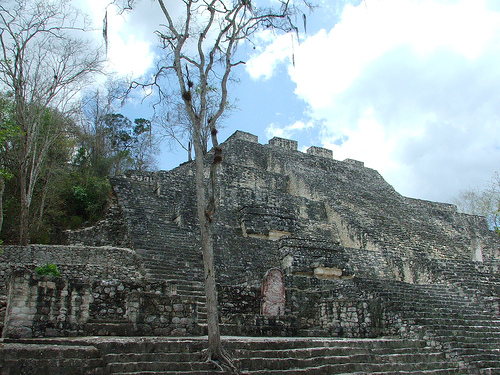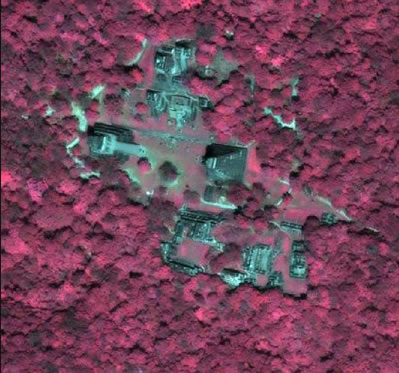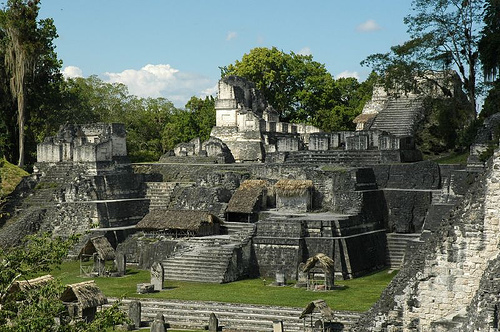
Jaguar Temple in Tikal (Image Credit: erushing [Flickr])

Mayan ruins at Calakmul, Mexico (Image Credit: von Kinder [Flickr])
Its people were highly advanced, mastering disciplines as varied as astronomy, engineering, architecture, and urban planning.
Today, however, these once-great Mayan cities lie hidden under dense rainforest. To the average American, how this happened is a mystery. We say the Maya “disappeared” and blame it on alien invaders. But the Maya aren’t gone. Millions of them still live in Guatemala and Honduras, and thousands more come to the United States to eke out livings as migrant laborers. It didn’t take a supernatural force to put their civilization into decline, either. In fact, archaeologists now blame the fall of the Maya on deceptively simple flaws that could topple any culture - even ours.
RAIN DROPS AREN’T FALLING ON MY HEADThese days, so few people live in the region once dominated by the Mayan empire that researchers believed there weren’t a lot of Maya living there in the past, either. But the landscape is deceptive. Decades of research reveal that the Maya had completely transformed the land on which they lived by turning jungles into a vast area of plains filled with cities, farms, and an ever-growing population. In fact, settlements around centers like Tikal reached population densities of up to 2,600 people per square mile. That’s more than half the population density of modern-day New York City.

The ancient ruins of Tikal, as captured by the IKONOS satellite
(Image: Space Imaging, Inc.)
As the Mayan population grew, however, the society became vulnerable to the limitations of their environment. They gobbled up the resources around them, but failed to develop new technologies that might have allowed them to adapt to changes in their natural surroundings. So when change finally did arrive in the form of drought, catastrophe wasn’t too far behind.
Archaeologist Richardson Gill blames the Mayan collapse on an extended period of drought that affected most of Mexico and Central America in the 9th century C.E. Of the more than 15 million Maya inhabiting the region at the time, many lived far from major rivers, so people relied on water collected in reservoirs during the rainy season. Of course, when climate changes caused these reserves to drop to dangerous levels, it became impossible to feed the huge Mayan population. In 2003, Gill’s theories received support following the analysis of mud from lake bottom in the Yucatan. Essentially, the find confirmed they spread of deforestation, soil erosion, and drought. Sadly, famine and thirst appear to have contributed to widespread death and disease, eventually driving people out of the Mayan heartland.
While widely accepted, this theory of the Mayan collapse still leaves a lingering question. Evidence shows that most ancient civilizations dealt successfully with drought at one time or another; so why weren’t the Maya able to cope? The answer, according to recent research, was war.
AN OPEN WAR POLICY

Mayan ruler Chaan Muan with prisoners from a raid for sacrifices and slavery - from the murals of Bonampak (Image Credit: Ancient Mexico)
In the wake of new research, it appears that Mayan cities were locked in something similar to the Cold War, only hotter. Hieroglyphs in the area reveal that two metropolitan “super-powers,” Tikal and Calakmul, were bitter rivals for centuries. Skirmishes between the kings of each city grew increasingly violent, prompting both dynasties to build alliances with other cities via raids, conquest, and royal coups. But, as more and more cities got involved, the warfare spread.
In 2002, a few more clues came to light after archaeologists discovered a stunning new set of hieroglyphic texts carved into the steps of a palace staircase at Dos Pilas (uncovered thanks to an earthquake that hit the region the previous summer). The texts told the surprising story of renegade princes from Tikal, who tried to create an empire of their own by waging a full-force attack on their home city with the help of neighboring allies. Unfortunately, their timing was poor. The invasion occurred during the height of the drought, and the result was pure devastation. Pyramids and temples were torn apart to build fortifications, and what few trees were left in the razed rainforest were cut down to build fences. Eventually, farmers had to retreat to the fast-growing weeds. The war destroyed the cities, leaving behind ruins and refugees. The land could no longer support the population due to the drought, and the government was too weak to do anything about it due to the war. Rather than to remain in the cities and face death, the people scattered, and the jungle eventually reclaimed the land.
NOT-SO-UNSOLVABLE MYSTERIESIn the end, it was neither laser beams nor a migration to Atlantis that destroyed the Maya, but a simple failure to plan. Leaders put the majority of their resources into warfare, while simultaneously forgetting that those resources weren’t infinite.
Then, when a severe but conquerable drought crisis appears, they were unable to cope. In his new book Collapse: How Societies Choose to Fail or Succeed, Pulitzer Prize-winning author Jared Diamond claims that the scenario is more common than you might think, and that it maybe responsible for the fall of many ancient cultures we deem “mysterious.” Environmental destruction and the depletion of natural resources create vulnerability, especially in the face of natural disasters. And just like the Maya, the ultimate fate is rarely disappearance or extinction, but usually a decline from opulence to poverty.





No comments:
Post a Comment